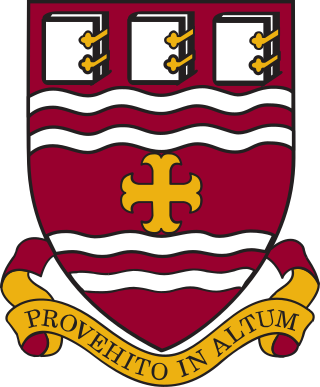Related Research Articles

Memorial University of Newfoundland, also known as Memorial University or MUN, is a public university in the province of Newfoundland and Labrador, based in St. John's, with satellite campuses in Corner Brook, elsewhere in Newfoundland and in Labrador, Saint Pierre, and Harlow, England. Memorial University offers certificate, diploma, undergraduate, graduate, and post-graduate programs, as well as online courses and degrees.

Sir Wilfred Thomason Grenfell was a British medical missionary to Newfoundland, who wrote books on his work and other topics.

St. Anthony is a town on the northern reaches of the Great Northern Peninsula of the Canadian province of Newfoundland and Labrador. St. Anthony serves as a main service centre for northern Newfoundland and southern Labrador. St. Anthony had a population of 2,180 in 2021, compared with 2,258 in 2016, 2,418 in 2011, 2,476 in 2006 and 2,730 in 2001.

Hebron was a Moravian mission and the northernmost settlement in Labrador. Founded in 1831, the mission disbanded in 1959. The Inuk Abraham Ulrikab and his family, exhibited in human zoos in Europe in 1880, were from Hebron.

Hopedale is a town located in the north of Labrador, the mainland portion of the Canadian province of Newfoundland and Labrador. Hopedale is the legislative capital of the Inuit Land Claims Area Nunatsiavut, and where the Nunatsiavut Assembly meets. As of the 2021 census it has a population of 596.

Colonel Cluny Macpherson was a physician and the inventor of an early gas mask. After World War I he served as the president of the St. John's Clinical Society and the Newfoundland Medical Association.

Battle Harbour is a summer fishing station, formerly a permanent settlement, located on the Labrador coast in the province of Newfoundland and Labrador, Canada. Battle Harbour was for two centuries the economic and social centre of the southeastern Labrador coast. Mercantile saltfish premises first established there in the 1770s developed into a thriving community that was known as the Capital of Labrador. It fell into decline following reductions in the cod fishery and a major fire in 1930, and was abandoned as a permanent settlement following government resettlement activity in the 1960s.
William Anthony Paddon, was a Canadian surgeon and the seventh lieutenant governor of Newfoundland from 1981 to 1986.

Lewis Varick Frissell was an American documentary filmmaker. His last film, The Viking, set in Newfoundland, involved the largest loss of life of the film production crew in film history. This film was also "the first film to record sound and dialogue on location".
John Shiwak was a Newfoundland sniper during the First World War. He was a member of the Newfoundland Regiment and noted as one of the best snipers in the British forces during the war.

Fishermen's Mission, officially The Royal National Mission to Deep Sea Fishermen, is a British charitable organisation founded to help those working in the UK's fishing industry. The charity, which is run on Christian principles, supports and welcomes persons of all faiths and none. It was founded at the end of the 19th century to provide assistance amd support to the impoverished fishing communties around the coasts of Britain.
Evarts Greene Loomis (1910–2003) was an internationally known physician, surgeon, author, lecturer, and visionary who is regarded by some as "the father of holistic medicine," Loomis preferred to be called Evarts rather than "doctor".
The International Grenfell Association (IGA) is an organization founded by Sir Wilfred Grenfell to provide health care, education, religious services, and rehabilitation and other social activities to the fisherman and coastal communities in northern Newfoundland and the coast of Labrador.

North West River is a small town located in central Labrador. Established in 1743 as a trading post by French Fur Trader Louis Fornel, the community later went on to become a hub for the Hudson's Bay Company and home to a hospital and school serving the needs of coastal Labrador. North West River is the oldest modern settlement in Labrador.
The Quebec-Labrador Foundation/Atlantic Centre for the Environment (QLF) is a not-for-profit organization in the U.S. and a registered charity in Canada. QLF's mission is twofold: to support the rural communities and environment of eastern Canada and New England, and to create models for stewardship and cultural heritage that can be applied worldwide.
Indian Harbour is a former settlement in Newfoundland and Labrador.
John Alastair Haggie is a Canadian politician, who was elected to the Newfoundland and Labrador House of Assembly in the 2015 provincial election. He represents the electoral district of Gander as a member of the Liberal Party.

The art of Newfoundland and Labrador has followed a unique artistic trajectory when compared to mainland Canada, due to the geographic seclusion and socio-economic history of the province. Labradorian art possesses its own historical lineage.
Kirkina Mucko also known as Elizabeth Mukko, (1890-1970) was a Canadian Inuit nurse and midwife. Having lost her legs as a child, and possibly her parents, she was raised in a series of mission homes, hospitals and boarding schools. Returning from abroad around 1908, she worked at the Grenfell Mission in Labrador. After losing family members in the 1918 flu pandemic, Mucko trained as a nurse and midwife, providing services for her community until her later years. A women's shelter in Rigolet has been named in her honor.
Henry Locke Paddon was a British doctor and medical missionary in Canada.
References
- ↑ Rompkey, Ron (2009). Grenfell of Labrador: A Biography. Montreal & Kingston: McGill-Queen's University Press.
- ↑ Lombard (2014). Adventures of a Grenfell Nurse. p. 32.
- ↑ Lombard, 2014, pp. 43-44
- ↑ The Grenfell Medical Mission and American support in Newfoundland and Labrador, 1890s-1940s. Connor, Jennifer J.,, Side, Katherine, 1963-. Montreal. 30 January 2019. ISBN 978-0-7735-5579-2. OCLC 1079055356.
{{cite book}}: CS1 maint: others (link) - ↑ Bickerdike, Rhonda Dawson. "Coll-198". Archives and Special Collections. Memorial University of Newfoundland - Digital Archives Initiative. Retrieved June 1, 2015.
- ↑ Helaine Fendelman (2004). "Rugs to Riches: Grenfell Hooked Textiles" Archived 2012-07-22 at archive.today Chubb Collectors website. Retrieved on 2006-11-07.